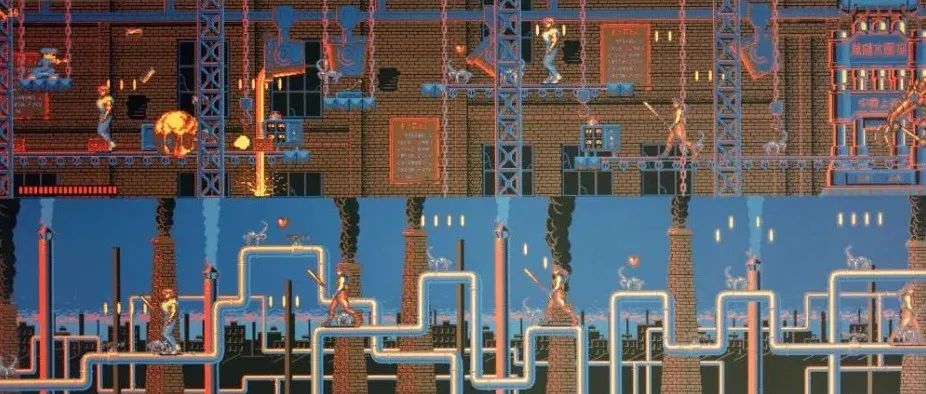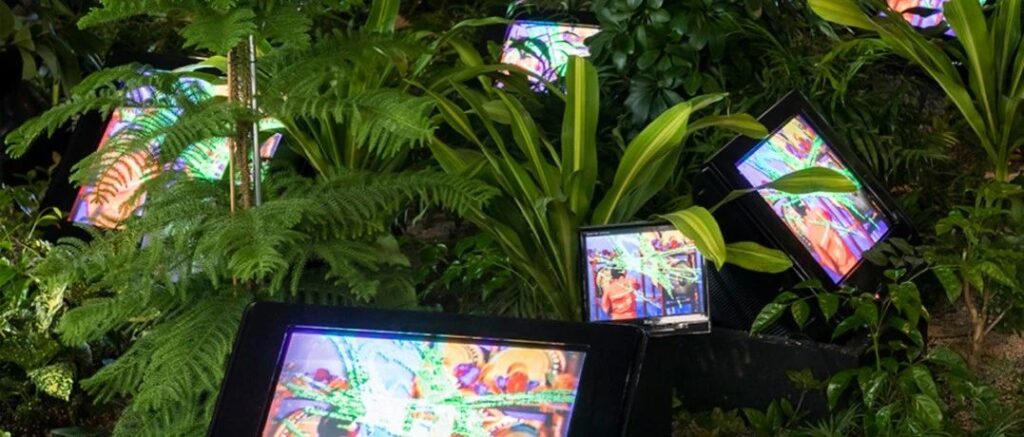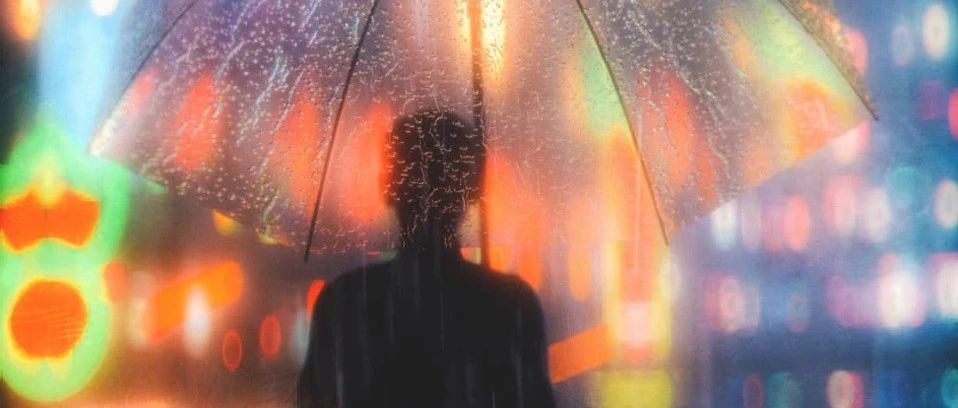
“It is only a matter of time before a virtual world will mix with the real world.”
“虚拟世界与现实世界的融合只是时间问题。”
– Feng Mengbo 冯梦波
About the artist
关于艺术家

Born in 1966, Feng Mengbo is a Chinese artist that was one of the first pioneers of digital technology and art in China. Graduating from the Central Academy of Fine Arts (CAFA) in Beijing, he serves as a Vice Director of the Printmaking Department at the Academic Committee of CAFA, focusing on research for traditional Chinese storytelling, virtual reality, and game engines. After traveling in Italy, he exhibited in the 45th Venice Biennale and would talk frequently with the prominent Korean artist that pioneered technological artforms, Nam June Paik. Working mainly in new media, Feng Mengbo’s art is largely characterized by his experience growing up during the Chinese Cultural Revolution and the economic reform. He has been at the forefront of blending elements of paint and technology, taking influence from the new forms of culture and lifestyle phenomena that shaped his generation. With a great interest in video games, he propels the medium as a tool of creation, exhibiting in galleries such as the Chambers Fine Art, New York, Shanghai Gallery of Art, Ullens Center for Contemporary Art (UCCA), Beijing, The East Bohemian Gallery of Fine Arts in Pardubice, Czech, UNT Visual Art Gallery, USA, The New England Institute of Art, and more.
冯梦波,出生于1966年,是一位中国的艺术家,也是中国最早的数字技术和艺术先驱者之一。从中央美术学院毕业后,他留在央美任学术委员会版画系副主任,专注于中国传统叙事、虚拟现实和游戏引擎的研究。意大利之旅后,他参加了第 45 届威尼斯双年展。同时他与科技艺术形式先驱者,著名韩国艺术家白南准(Nam June Paik)一直保持交流。冯梦波主要从事新媒体创作,其艺术的主要特点是反映他在文化大革命和经济改革中的成长经历。他因受到塑造了他这一代人的文化形式和生活方式的影响,一直站在融合传统绘画和技术元素的最前沿。他对电子游戏有着浓厚的兴趣,将媒体作为一种创作工具,他的作品曾展出在纽约Chambers Fine Art,上海美术馆,北京尤伦斯当代艺术中心 (UCCA),捷克东波西米亚美术馆,美国 UNT 视觉艺术画廊、新英格兰艺术学院等。
A pioneer of digital art
数字艺术的先驱

Having grown up during the rapid social change of the cultural revolution, Mengbo’s life experience is an essential part of his creative development. With the opening of China and the economic reform that took place, Mengbo was exposed to an influx of foreign cultural content and goods. Games in particular have influenced the direction of his work for a long period during his artistic career until he pivoted back into traditional Chinese art forms. In fact, he was so immersed in gaming that he would teach himself coding in order to insert himself as an avatar inside the video game Quake III Arena. All of this has led the artist to showcase a more innovative side to art by pioneering the field into the digital realm in China. He has been at the forefront of innovation in his field and now stands as a prominent artist that defined a new way of experiencing, creating, and trading art.
冯梦波成长于文革时期,在快速的社会变革中,他的生活经历是他创作发展的重要组成部分。随着中国的开放和发生的经济改革,冯梦波接触到大量外国文化和商品。尤其是游戏,在他的艺术生涯中曾经长时间影响其创作方向,直到他重新转向中国传统艺术形式。事实上,他如此沉迷于游戏,以至于他自学编程,将自己的化身编进电子游戏 “Quake III Arena”中。所有这一切都让都展示了他在国内开创了数字艺术领域的先河,呈现了艺术更具创新性的一面。他一直处于该领域创新的最前沿,成为了一位杰出的艺术家,他定义了一种体验、创造和交易艺术的新方式。

His works feature the perfumes of history, culture, as well as Chinese heritage as seen in works such as his iconic, Long March video game art series. Various pop culture gaming references such as Street Fighter’s Chun Li among other characters populate his canvas both in painting and pixelated forms. Now the world has reached a new era of web 3.0 where metaverse has become a new buzzword across the world, but for Mengbo, it seems not so different from the games and worlds he has been creating through his art. It may be better to say that he may have already been connected to the metaverse when he had first picked up his console’s controller over 20 years ago.
如他标志性的名为“长征”的电子游戏艺术作品系列中所能见到的那样,他的创作以历史、文化以及中国传统为特色,加入了各种流行文化游戏作为参考,例如街头霸王的春丽等角色,用绘画和像素化形式填充了他的画布。现在世界已经进入了 web 3.0 的新时代,元宇宙已经成为全球的新流行语,但对于冯梦波来说,这似乎与他通过艺术创造的游戏和世界并没有太大的不同。当20 多年前他第一次拿起控制台的遥控器时,他可能就已经连接到了元宇宙。
At the same time, Mengbo has been examining the possibility of NFTs, albeit it took some time for him to begin embracing the path into this seemingly risky territory as a Chinese artist. While China has banned the use of cryptocurrencies, Feng did not see that as the end of the journey. It was just an obstacle that he must be wary of.
与此同时,冯梦波一直在研究 NFT 的可能性,尽管作为一名中国艺术家,他花了一些时间才开始接受进入这个看似危险领域的道路。虽然中国已经禁止使用加密货币,但冯梦波并不认为这是旅程的终点。这只是他必须克服的障碍。
The Long March
长征

“Game Over: Long March”, which is housed in the permanent collection of the Guggenheim museum in Abu Dhabi, is the first step of Feng Mengbo’s immersion into video game art. In 1993 he created 42 canvases referred to as, “game snapshots” in the form of storyboards for a side-scrolling game. These works are personal to Feng’s interest in gaming as well as his experiences growing up in China. Gaming culture plays a big part in this series and it is eventually continued by his 2008 video game titled, “Long March: Restart” which is in permanent collections in the likes of White Rabbit, MOMA, M+ Museum, LACMA, Guggenheim at Abu Dhabi, and Ullen’s collections. This game is not only a work of art but is an actual playable video game based on the widely popular Nintendo game, Super Mario Bros. In the game, the protagonist is played by a Red Army soldier denoted by his attire and hat with a red star. Taking the rapid transformation and memories of Feng in the making of modern-day China that we see today, the artist gives us a look from his perspective at the long-lasting experiences and history of people from his time. The character treks throughout Chinese landscapes obliterating his foes to save the Princess like in Super Mario. The title, “Long March” is a reference to the retreat of the Chinese Red Army led by the likes of Mao Zedong and other key Chinese figures in 1934 from the Chinese Nationalist Party Army. The retreat lasted over a year for about 8,000 miles and cemented Mao’s path to becoming the leader of China in the years to come.
被阿布扎比古根海姆博物馆永久收藏的作品《游戏结束:长征》是冯梦波涉足电子游戏艺术的第一步。1993 年,他以故事板的形式为卷轴类动作游戏创作了 42 幅被称为“游戏快照”的画布。这些作品是冯梦波对游戏的兴趣,以及他在中国长大的经历。游戏文化在这个系列中发挥了重要作用,最终在他2008 年创作的电子游戏《长征:重启》中继续呈现,该游戏被White Rabbit、MOMA、M+ 博物馆、LACMA、阿布扎比的古根海姆等机构永久收藏,同时被Ullen’s collections收藏。该游戏不仅是一件艺术品,而且是基于广受欢迎的任天堂游戏《超级马里奥兄弟》的一款实际可操作的视频游戏。在游戏中,主角由一名红军战士扮演,他的服装和帽子带有红色星星。在今天我们可以看到的现代中国建设过程中,记忆快速更迭,冯梦波从他的角度向我们展示了他那个时代人们悠久的经历和历史。这个角色跋涉在中国的风景中,像在超级马里奥中一样消灭他的敌人来拯救公主。标题“长征”是指1934年毛泽东等中国重要人物领导的中国红军从中国国民党军队围剿中撤退。这次撤退持续了一年多,大约 8,000 英里,巩固了毛泽东在未来几年成为中国领导人的道路。


“The Long March is a manifesto… It has proclaimed their utter failure to encircle, pursue, obstruct and intercept us. The Long March is also a propaganda force. It has announced to some 200 million people in eleven provinces that the road of the Red Army is their only road to liberation.”
长征又是宣言书……长征宣告了帝国主义和蒋介石围追堵截的破产。长征又是宣传队。它向十一个省内大约两万万人民宣布只有红军的道路,才是解放他们的道路。
– Mao Zedong, from the report “On Tactics Against Japanese Imperialism” (1935)
– 毛泽东,摘自《论反对日本帝国主义的策略》(1935)

Beyond the feat of creating a functional game from scratch as an artist based on his first series of storyboard artworks, he has intentionally created a work with great magnitude and scale that calls for a gigantic display which is estimated to be around 80 by 20 feet inside an exhibition hall.
除了他的第一个基于故事板的系列艺术品,始创了功能性游戏的成就之外,他还创造了一件规模巨大的作品,在一个展厅内展示一个尺寸约为 80 x 20 英尺的巨型作品。
“(The) original intention in designing the installation, which lies in the continued use of the audience’s, i.e. the gamers’, way of motion as the chief measuring mechanism…I wanted to enable the character to move freely along the stretched scroll. Because of the vast space of the exhibition hall and the intentionally designed pace of the character, the gamer and the audience would have to dash to catch up with the character.”
“这个装置的设计初衷,在于用观众,即游戏玩家的运动方式作为主要的评分机制……我想让角色沿着拉伸的卷轴自由移动。展厅空间广阔,加上人物刻意设计的节奏,玩家和观众都不得不冲上去追赶角色。”
– Feng Mengbo 冯梦波
Jumping into NFTs and the metaverse
进入入NFT 和元宇宙

With a portfolio as an early adopter of new technologies, it came as a surprise to many around Feng Mengbo that he was not working in NFT. In fact, his view of NFTs carried many concerns as he explains: “ In my opinion, NFT and art are not necessarily related. Currently, NFT is hyped and it may be more of an extension of a financial tool. Several extremely successful stories of NFT have obvious hype methods and are not universal. Because the content of digital prints is relatively small, it may be feasible to use NFT technology for packaging and circulation, but it remains to be observed and experimented on. However, for relatively large-scale digital media works, especially works with specific hardware and space requirements, NFT cannot satisfy them.”
曾经产出了多件数字艺术作品,且作为新技术的早期采用者,令冯梦波周围的许多人感到惊讶的是,他没有创作NFT作品 。事实上,他对 NFT 的看法有诸多担忧,正如他解释的那样:“在我看来,NFT 和艺术不一定相关。目前,NFT 被大肆宣传,它可能更像是一种金融工具的延伸。NFT 的几个极其成功的故事都有明显的炒作方式,并不具有普遍性。由于数字印刷的内容相对较少,使用NFT技术进行包装流通或许是可行的,但仍有待观察和试验。但是,对于规模比较大的数字媒体作品,尤其是对硬件和空间有特定要求的作品,NFT 无法满足。”

In fact, how can Chinese artists actually create NFTs if cryptocurrencies are banned in China? Blockchain technology has potential in terms of handling provenance, exclusivity, and transparent dealings that are often criticized in the art world. Although the market is inflated in many areas, there are more sustainable ways of leveraging such a technology to make art more inclusive. At the same time, cryptocurrencies may not be necessary as they can be replaced with fiat currency and while many still question the value it has as a piece of art and a digital asset, what is evident is that it is a new tool that is innovating the art world. The only problem is that there is much work to be done on all sides to ensure a clear development path that will redefine how we experience art and culture as it will forever change the way we live in the future. What’s to actually happen to the adoption of these technologies, only time will tell.
事实上,如果加密货币在中国被禁止,中国艺术家如何真正创造 NFT?区块链技术在处理艺术界经常批判的作品出处、排他性和透明交易方面具有潜力。尽管市场在许多领域都在膨胀,但有更多可持续的方式可以利用这种技术使艺术更具包容性。同时,加密货币不是必需的,因为它们可以被法定货币取代,虽然许多人仍然质疑它作为一件艺术品和数字资产的价值,但显而易见的是,它正在成为艺术进化里的一种新工具。唯一的问题是,要确保一条清晰的发展道路,重新定义我们体验艺术和文化的方式,改变我们未来的生活方式,各方面都还有很多工作要做。运用这些技术实际上会发生什么,只有时间能揭示答案。

After various talks and offers to create NFT works, Feng finally gave in to the demand, announcing his first NFT partnership in February 2022 with Miralab. This change of heart seems especially fortified by the possibilities of the metaverse on which he remarks: “(The metaverse) is not something new. For 20 years we have all been in the metaverse, we just didn’t realize it. For example, how many hours do you use your computer or your mobile phone and social media, and everything else? All feedback now comes through the computer and not through the real world. These days I’m logged in permanently to WeChat. Do you remember the Tamagotchi cat from the late 1990s? Children could look after them. Virtually feed them, take care of them. They were very low tech but children and young people put their emotions into them. And this is what people will do in the metaverse. I’m not saying that the future is necessarily good but simply that it has already happened,”
经过多次讨论,并接到要创作 NFT 作品的需求后,冯梦波终于屈服,于 2022 年 2 月宣布与 Miralab 建立第一个 NFT 合作伙伴关系。元宇宙的可能性似乎特别强化了这种改变,他评论说:“(元宇宙)并不是什么新鲜事物。20 年来,我们都在元宇宙中,只是没有意识到。例如,使用电脑或手机和社交媒体的时间,以及其他等等。现在所有的反馈都来自计算机,而不是现实世界。这些天我永久登录微信。你还记得 1990 年代后期的电子宠物?孩子们可以领养他们。在虚拟空间里喂养,照顾他们。它们的技术含量很低,但儿童和年轻人将他们的情感投入其中。这就是人们在元宇宙中会做的事情。我并不是说未来一定是好的,只是说它已经发生了,”

While he has not explicitly expressed so, we can see a path of Feng Mengbo’s works being recreated for the metaverse as interactive elements that preserve the essence of his life, personal experiences, social changes he endured, and the heritage that defines who he is today.
虽然他没有明确表达,我们仍然可以看出,冯梦波的作品正通过一种途径在为了适应元宇宙而再现。这些成为了一种互动的元素,保留了他个人的经历,生命中的精华,所历经的社会变迁,以及那些塑造他的历史传承。
*all images and artworks belong to the artist & his representing galleries respectively
*所有图像和艺术品分别属于艺术家及其他们代表的画廊
Translation 翻译 Rona Xia
FOR MORE RELATED CONTENT
本篇文章来源于微信公众号: SHMADNESS








